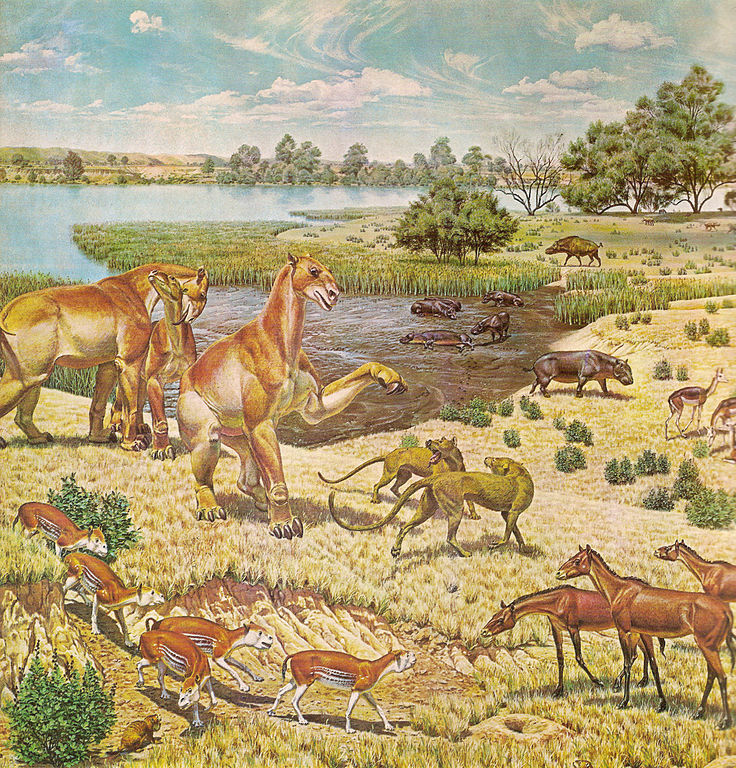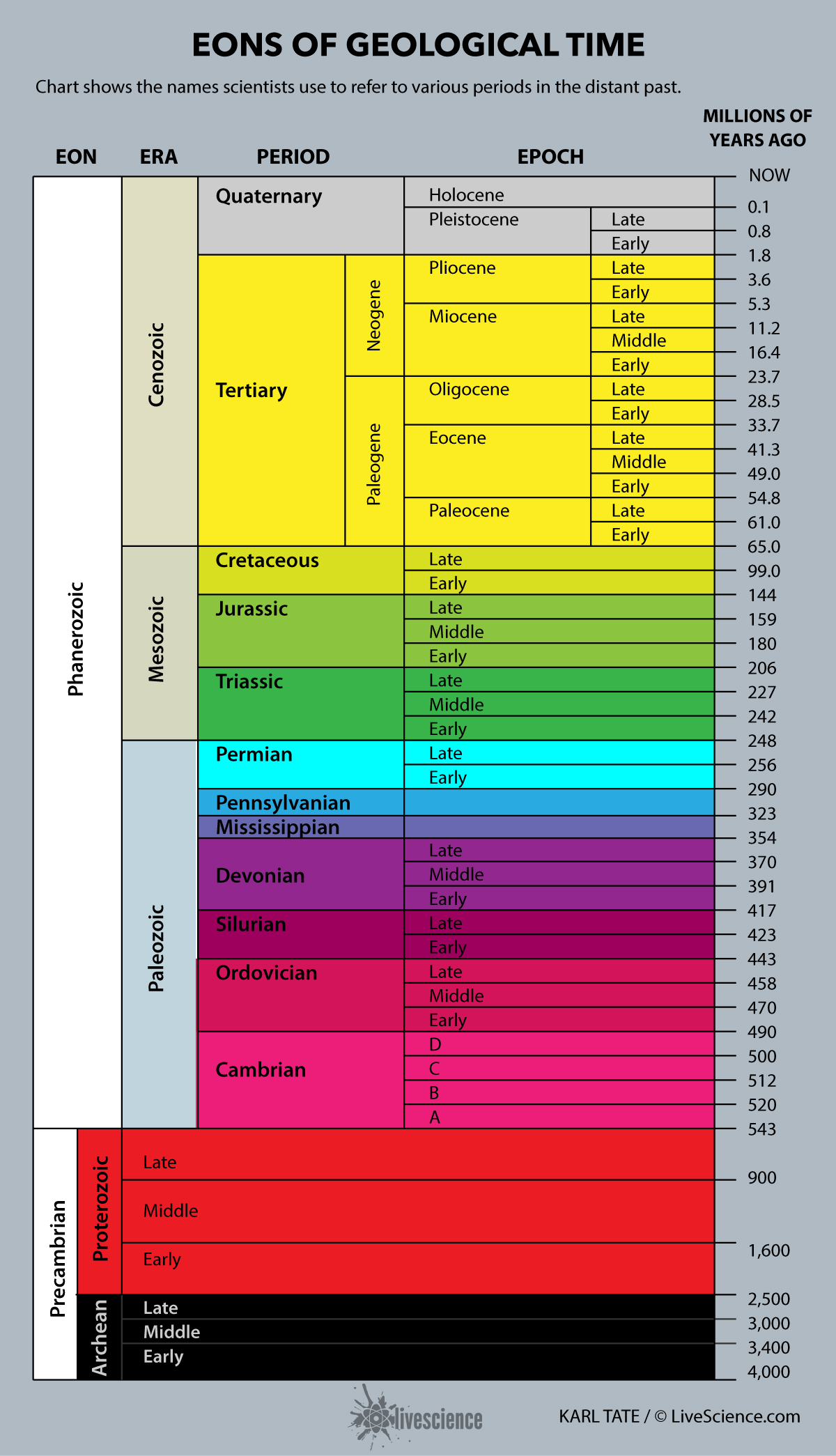Cenozoic era: Facts about climate, animals & plants
The Cenozoic era began about 65 million years ago and continues into the present.

The Cenozoic era, which began about 65 million years ago and continues into the present, is the third documented era in the history of Earth. The current locations of the continents and their modern-day inhabitants, including humans, can be traced to this period.
The era began on a big down note, catching the tail end of the Cretaceous-Paleogene extinction event at the close of the Cretaceous period that wiped out the remaining non-avian dinosaurs.
The term Cenozoic, first spelled "Kainozoic," was originally used in an 1840 entry in the Penny Cyclopedia encyclopedia in an article written by British geologist John Phillips. The name is derived from the Greek phrase meaning “recent life.”
The Cenozoic era is divided into three periods:
- Paleogene period (65-23 million years ago), which consists of the Paleocene, Eocene and Oligocene epochs);
- Neogene period (23-2.6 million years ago), which includes the Miocene and Pliocene epochs);
- Quaternary period (2.6 million years ago to the present), consisting of the Pleistocene and Holocene epochs). While it is widely accepted that we are still in the Holocene epoch, some scientists argue that we have entered the Anthropocene epoch. In a 2010 article in the scientific journal Environmental Science & Technology, scientists made the case for a new epoch, blaming humans for causing a drastic shift in conditions.
Climate and geography
The global climate of the early portion of the Cenozoic period was much warmer than it is today, and the overall climate of the Earth was much more consistent regardless of proximity to the equator.
The most significant period of global warming, known as the Paleocene–Eocene Thermal Maximum, took place of 55.8 million years ago. It was followed by a long cool, dry period. The current global warming event has been set off primarily by human activity.
Each segment of the Cenozoic experienced different climates. During the Paleogene period, most of the Earth’s climate was tropical. The Neogene period saw a drastic cooling, which continued into the Pleistocene epoch of the Quaternary period.
As for the changing landscape, the continents drifted apart during the Paleogene period, creating vast stretches of oceans. This had a significant impact on the climate and marine life surrounding each continent.
During the Pleistocene epoch, glaciers covered central North America, extending as far east as New York, south to Kansas and Nebraska and west to the northern West Coast. The Great Lakes were formed as the glaciers receded.
Several of the world’s foremost mountain ranges, including the Alps, Himalayas and the Rocky Mountains, were formed during the Cenozoic era.
Life during the Cenozoic Era
The Cenozoic era is also known as the Age of Mammals because the extinction of many groups of giant mammals, allowing smaller species to thrive and diversify because their predators no longer existed. Due to the large span of time covered by the period, it is beneficial to discuss the animal population by the milestone of the era rather than in generalities.
The beginning of the Paleogene period was a time for the mammals that survived from the Cretaceous period. Later in this period, rodents and small horses, such as Hyracotherium, are common and rhinoceroses and elephants appear. As the period ends, dogs, cats and pigs become commonplace. Other than a few birds that were classified as dinosaurs, most notable the Titanis, the dinosaurs were gone. Large flightless birds, such as the Diatryma, thrived.
The Neogene period gives rise to early primates, including early humans. Bovids, including cattle, sheep, goats, antelope and gazelle, flourish during this period.
Cave lions, sabre-toothed cats, cave bears, giant deer, woolly rhinoceroses, and woolly mammoths were prevailing species of the Quaternary period.
Without the dinosaurs, plant life had an opportunity to flourish during the Cenozoic era. Nearly every plant living today had its roots in the Cenozoic era. During the early part of the era, forests overran most of North America. However, as the climate cooled forests died off, creating open land.
Due to the widening of the oceans, sharks, whales and other marine life proliferated. The Great Lakes that formed in the western United States during the Eocene epoch were the perfect home for bass, trout and other fresh-water species.
As the forests thinned, grasses began to spread out over the plains of North America and savannas covered the land in the middle of the continent. Among the common plant life were pines, mosses, oaks and grasses. Flowering plants and edible crops dominate the landscape in the later part of this era as humans cultivate the land.

Other time periods
Precambrian: Facts About the Beginning of Time
Paleozoic Era: Facts & Information
- Cambrian Period: Facts & Information
- Silurian Period Facts: Climate, Animals & Plants
- Devonian Period: Climate, Animals & Plants
- Permian Period: Climate, Animals & Plants
Sign up for the Live Science daily newsletter now
Get the world’s most fascinating discoveries delivered straight to your inbox.
Kim Ann Zimmermann is a contributor to Live Science and sister site Space.com, writing mainly evergreen reference articles that provide background on myriad scientific topics, from astronauts to climate, and from culture to medicine. Her work can also be found in Business News Daily and KM World. She holds a bachelor’s degree in communications from Glassboro State College (now known as Rowan University) in New Jersey.










